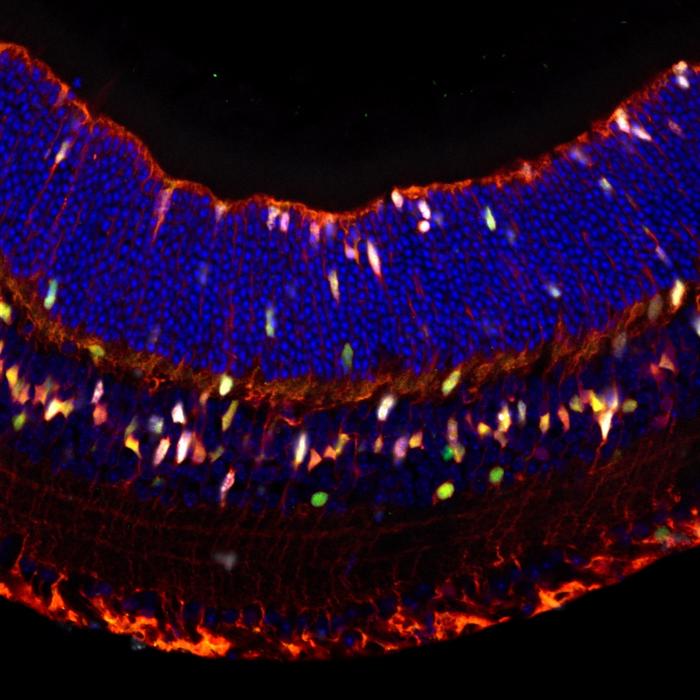In a groundbreaking study conducted at the USC Stem Cell laboratory, researchers have unveiled crucial insights into the mechanisms regulating cell regeneration within sensory organs like the ear and the retina. This innovative research led by Ksenia Gnedeva, PhD, sheds light on the potential to unlock pathways necessary for regaining hearing and vision in mammals, including humans. Published in the Proceedings of the National Academy of Sciences, the findings underscore the significance of specific genetic interactions that could pave the way for therapeutic breakthroughs in regenerative medicine.
The mammalian body exhibits a remarkable ability to heal wounds, yet this regenerative capacity dramatically diminishes when it comes to the inner ear and retina. The study’s core revelation revolves around the pivotal role of a group of genes known as the Hippo pathway. Typically functioning as a “stop growing” signal, the Hippo pathway has been identified as a critical factor inhibiting the proliferation of sensory receptor cells following injury. Understanding the genes that maintain this inhibitory blockade is of paramount importance for advancing restoration efforts in sensory functionality.
In the research, the first authors, Eva Jahanshir and Juan Llamas, meticulously explored the Hippo pathway’s interactions and its ability to stifle cell regeneration during injury-response events. Through their investigations, they illustrated the pathway’s dual role, not only being integral during embryonic development but also serving as a formidable barrier to regeneration in adult organisms. The implications of these findings are significant, as they suggest new strategic avenues to manipulate this signaling pathway for regenerative purposes.
One of the experimental techniques employed involved the use of a novel compound designed to inhibit a key protein in the Hippo pathway—known as Lats1/2. The researchers deployed this compound in controlled Petri dish environments harboring progenitor cells known as supporting cells. The results were striking; the compound prompted these supporting cells located in the utricle, a sensory organ in the inner ear responsible for balance, to begin proliferating. However, this same effect was not observed in the organ of Corti, the part of the auditory system responsible for hearing, signaling a complex interaction between the Hippo pathway and regeneration processes.
Digging deeper into the inhibition of sensory cell regeneration, the researchers pinpointed a crucial gene that encodes a protein named p27Kip1. This protein appears to act as a roadblock in the organ of Corti and is significantly elevated in retina regions. To unravel the implications of p27Kip1, the team developed transgenic mice that allowed them to manipulate its expression levels specifically in the inner ear and the retina. The results were profoundly illuminating; inhibiting the Hippo pathway in these genetically altered mice led to an increase in the proliferation of supporting cells in the organ of Corti.
Moreover, the team observed that in the retina, similar inhibition of the Hippo pathway stimulated the proliferation of Müller glia progenitor cells. Remarkably, without any additional manipulations, some of these progeny transformed into sensory photoreceptors and various neuronal cell types, indicating a previously unappreciated flexibility in the fate of these progenitor cells. This discovery provides substantial optimism regarding the regenerative potential of glial cells in mammalian sensory systems.
Gnedeva expressed excitement about the possibility of using their findings to foster regeneration in humans. She noted that previous reports indicated p27Kip1 levels decrease following injuries, thus creating a window of opportunity for drug interventions aimed at inhibiting the Hippo pathway. This insight could lead to the development of pharmacological agents tailored to enhance sensory cell regeneration following trauma, whether in the auditory system or the visual pathways.
This transformative research not only spotlighted the role of the Hippo pathway and p27Kip1 but also emphasized their overarching significance in the arena of regenerative medicine. With the potential to devise compounds that either inhibit the Hippo pathway or diminish p27Kip1 levels, the goal of fostering regeneration in hearing and vision could soon transition from theoretical discourse to clinical application. Researchers have identified remarkable targets that could revolutionize how we approach degenerative diseases affecting sensory organs.
The collaborative nature of the research team, including co-authors Yeeun Kim, Kevin Biju, and Sanyukta Oak, further exemplifies the importance of interdisciplinary efforts in transcending traditional boundaries of scientific inquiry. The study received robust support from federal funding, underscoring a collective commitment to advancing scientific understanding and practical applications in regenerative medicine.
In conclusion, the study underlines the untapped potential held within the interactions of specific signaling pathways and their critical functions in organ regeneration. It sets the stage for a new era of regenerative research wherein the complexities of genetic interactions are understood, leveraged, and ultimately translated into therapy aimed at restoring lost sensory functions.
Subject of Research: Animals
Article Title: The Hippo pathway and p27Kip1 cooperate to suppress mitotic regeneration in the organ of Corti and the retina
News Publication Date: 4-Apr-2025
Web References: DOI
References:
Image Credits: Credit: Image by Ksenia Gnedeva/USC
Keywords: Regeneration, Hippo pathway, Kinase inhibitors, Retina, Stem cell research, Discovery research, Transgenic mice, Progenitor cells, Auditory perception, Inner ear, Sensory receptors, Glia.
Tags: auditory and visual restorationcell proliferation inhibitiongene interactions in hearinggenetic factors in sensory healinggroundbreaking findings in regenerative biologyHippo pathway in mammalsinjury response in sensory cellsregenerative capacity in mammalsretina regeneration mechanismssensory organ regenerationtherapeutic breakthroughs in regenerative medicineUSC Stem Cell research





